
Arquivo para a ‘Tecnologia’ Categoria
Pré-ocupação: entre a ocultação e o mistério
Conforme desenvolvemos os temas da semana passada, a clareira é a morada do Ser, de modo geral e dentro de determinados contextos: “o que está oculto dentro do todo, e de onde deve emergir o Ser” que elaboramos ali, isto é o que encanta as primeiras imagens do observatório James Webb, dentro do contexto do universo, olhar para grandes mistérios e fenômenos ali.
é a morada do Ser, de modo geral e dentro de determinados contextos: “o que está oculto dentro do todo, e de onde deve emergir o Ser” que elaboramos ali, isto é o que encanta as primeiras imagens do observatório James Webb, dentro do contexto do universo, olhar para grandes mistérios e fenômenos ali.
Sair da ocupação e entrar no mistério é assim deste modo uma expansão do Ser, quando descobrimos um mundo novo no final da idade média, também um conjunto de descobertas em torno da ciência foram sendo iluminadas e também elas foram início de uma clareira, porém o vínculo estreito ao subjetivismo, o trajeto de um objetivismo materialista voltara a ocultar.
Pré-ocupação, significa aquilo que ocupa a nossa mente e por consequência nosso ato, se desenvolve na roda-viva da modernidade em uma “sociedade do cansaço”, onde a pré-ocupação leva ao mesmo tempo a um esgotamento mental e social, e uma falta de contemplação, ou seja, nossa incapacidade de “admirar e pensar sobre alguma coisa” num estado contemplativo.
Assim só é possível sair da pré-ocupação por um processo de clareira do Ser, um mergulho no mistério, uma capacidade de “colocar entre parêntesis” nossos pensamentos e atos (o método do epoché fenomenológico), e assim voltar a “respirar” e sair da toxidade do mundo moderno, não deixamos de analisar e observar os graves fatos da contemporaneidade.
Assim a ocultação, a mitificação ou falsa “mistificação” da realidade é oposta à clareira, e muito diferente do ocultismo, o exemplo das imagens e estudos do James Webb são uma clara visão deste mergulho no mistério, onde sempre podemos encontrar novidades e novos enigmas.
A pré-ocupação é a mesmice do mundo contemporâneo, falsos problemas e problemas verdadeiros ocultos em discursos e modos viciados de enxergar a realidade, como alguém com dificuldade de visão e que não se sujeita ao uso de óculos para clarificar a realidade.
Contemplar é um ato complementar com a vida ativa, e só ela permite uma unidade do Ser, onde mesmo sobre momentos sombrios há luz e serenidade.
As 5 primeiras imagens do Observatório James Webb
Chegaram as primeiras imagens coloridas do James Webb,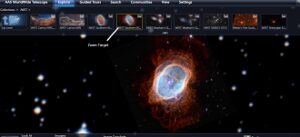 de fato são incríveis e também as ferramentas disponíveis para os usuários, além é claro de todos os recursos internos dele.
de fato são incríveis e também as ferramentas disponíveis para os usuários, além é claro de todos os recursos internos dele.
Um alvo histórico era o Quinteto de Stephan, primeiro grupo compacto de galáxias que foi descoberto em 1787, está na constelação de Pegasus, como diz o nome são cinco galáxias, quatro das quais fazem uma dança entre elas e duas estão bem próximas.
O nascimento no chamado Anel do Sul, uma imensa nuvem de gás que cerca uma estrela moribunda resultado de oito explosões de um antigo sol agora reduzido a uma anã branca.
Um autêntico “berçário” de estrela, os pontos brancos dentro de uma enorme “montanha mística” feita por elementos que “alimentam” a formação de estrela, a chamada nebulosa Carina.
As outras imagens igualmente espetaculares foram o primeiro exoplaneta gigante, mais ou menos metade do tamanho de Júpiter, de WASP-96 b, descoberto em 2014 e que foi mostrado com uso dos recursos internos o espectro de elementos presentes nele, isto é, se tem água e outros elementos químicos que o compõe.
E por fim uma quinta imagem foi mostrada do aglomerado de galáxias, SMACS 0723, que funciona como se fosse uma lupa cósmica para enxergar e ver como são outras galáxias e está é só a primeira.
O uso de uma ferramenta de zoom disponível permite que você escolha o alvo (escolha acima o quadro JWST e aparece a opção das 5 imagens) e faça o passeio viajando milhões de anos-luz e tendo uma experiência parecida aos cientistas.
Um tapa no Oscar
Tinha decidido não comentar os melhores do Oscar este ano, primeiro porque não considero “Ataque de cães” tão bom filme, quanto por exemplo, Duna e Não Olhe para cima, não apenas pelos enredos, mas principalmente pelo conjunto da obra, Duna acabou levando vários prêmios merecidos, mas nenhum dos principais.
primeiro porque não considero “Ataque de cães” tão bom filme, quanto por exemplo, Duna e Não Olhe para cima, não apenas pelos enredos, mas principalmente pelo conjunto da obra, Duna acabou levando vários prêmios merecidos, mas nenhum dos principais.
O tapa de Will Smith em Chris Rock roubou a cena, mas o comentário da diretora Jane Campion que ganhou melhor direção, em outro evento sobre Serene e Venus Williams: “vocês são maravilhosas, no entanto, não precisam competir com os homens como eu”, também caiu mal e seu prêmio perdeu um pouco do brilho.
Pouco tempo depois do tapa de Will Smith ele receberia o prêmio de melhor ator, é um grande ator, mas seria mais grandioso se esperasse este momento para dizer sobre o papel que fez do pai das Williams em defesa da família e daria um golpe muito mais duro em Rock, por ter feito um comentário infeliz sobre a perda de cabelos de Jada Pinkett, mulher de Will.
Muita gente saiu em defesa de Rock, dizem os jornais que seu show agora bate records de bilheteria, e Will expôs Jada porque agora procuram saber da vida dela e de seus relacionamentos, e assim como sua doença alopecia, enfim na minha opinião, o momento de resposta a Chris Rock poderia ser o momento da estatueta, e neste caso não vou comentar o mérito, porém o papel de Denzel Washington na Tragédia de MacBeth merece destaque.
Outro comentário é o prêmio de melhor atriz, fui ver depois da indicação trechos (não vi o filme todo) Os olhos de Tammy Faye (foto), nem o filme nem a atriz vencedora (Jessica Chastain) me impressionam, eu sei que a Academia seguem alguns clichês: ironia, certo humor e outros tiques.
Fui ver a popularidade, pouco mais de 60% das pessoas gostaram do filme, não estou fora então.
Vi a atuação de Meryl Streep em Não Olhe para cima, e merecia ao menos a indicação, claro já ganhou outros, é uma atriz consagrada (o papel espetacular de Margareth Thatcher na Dama de Ferro, por exemplo), mas mérito é indiscutível e não importa a estatura do ganhador.
O tapa de Will Smith e a bola fora esquecida da vencedora de Melhor Direção chamaram a atenção para um Oscar a meu ver sem brilho e ao gosto da academia, o tapa foi um erro só isto.
Não olhe para cima: entre a ficção e o documentário
O filme da Netflix é uma ficção, mas o estilo ficou parecido a um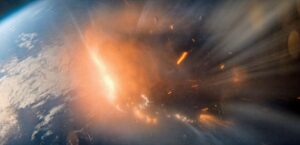 documentário, e diferente de outros filmes apocalípticos (“Armageddon” (1998), “Impacto Profundo” (1998) e “Procura-se um Amigo Para o Fim do Mundo” (2012)) o filme “Não olhe para cima” tem um impacto diferente por conta das ondas apocalípticas que encontram público.
documentário, e diferente de outros filmes apocalípticos (“Armageddon” (1998), “Impacto Profundo” (1998) e “Procura-se um Amigo Para o Fim do Mundo” (2012)) o filme “Não olhe para cima” tem um impacto diferente por conta das ondas apocalípticas que encontram público.
O filme fala de um professor, o Dr. Randall Mindy (Leonardo DiCaprio) e sua aluna estudante de astronomia Kate Dibiasky (Jennifer Lawrence) fazem a descoberta de um cometa com um tempo curto para colidir com a terra, seis meses, e querem conseguir chamar atenção da mídia que prefere dirigir o público para as mídias de redes sociais e pouco preocupado com suas próprias vidas, qualquer semelhança com a pandemia não é mera coincidência, há uma correlação, em especial, de sentimentos e atitudes.
As coisas começam a mudar quando o Dr. Oglethorpe (Rob Morgan) organiza um tour midiático até o gabinete da presidente Orlean (Meryl Streep) e seu filho Jason (JOnah Hill) e também com ajuda das ondas de rádio do Daily rip, um programa matinal apresentado por Brie (Cate Blanchett)e Jack (Tyler Perry) e começa uma corrida contra o tempo.
Além dos extraordinários atores, o filme prende a atenção, e já é cotado para premiações, o tema, porém é tratado de modo quase como um documentário e isto é preocupante.
As mensagens de final de ano normalmente são animadoras e falam quase sempre de esperança de um ano melhor, depois de dois anos caóticos pela situação pandêmica, o filme de ficção deveria ter um caráter ficcional como tem muitos filmes do chamado “cinema catástrofe”, e as pessoas assistem sempre entendendo que é uma ficção, porém a época e as teorias conspiratórios podem colaborar para um filme que tenha um impacto negativo nas emoções de quem assiste.
Lembro do último que assistir neste estilo que foi o filme norueguês Terremoto (2018), que o Geólogo Kristian (Kristoffer Joner) decide investigar os túneis de Oslo, onde há muitos anos ocorreu um grande terremoto, e encontra Marit (Katherine Thorborg Johansen) que é filha de um geólogo que morreu ao investigar as minas de Oslo.
O problema é sempre como evitar tragédia, claro se for possível, assim não tome a vacina é semelhante a “não olhe para cima”.
Ambos decidem, na iminência de um novo terremoto, salvar o maior número possível de pessoas.
A esperança não deve partir de que uma tragédia não possa acontecer, como um prolongamento ou uma nova pandemia, mas as medidas preventivas que podem salvar, porém “Não olhar para cima” parece mais um desespero que de fato uma tentativa de evitar novas catástrofes, vai dar o que falar.
Vulcões e possibilidades de terremotos
Além da crise civilizatória, as forças da natureza parecem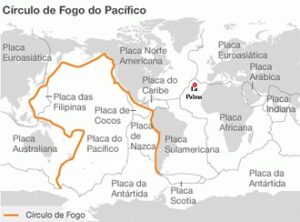 estar mais despertas que o normal, o vulcão das ilha La Palma, do arquipélago das Canárias, território da Espanha, desperta grande interesse pelo volume de lava que espero chegando perto já de dois meses e sem dar sinais de trégua.
estar mais despertas que o normal, o vulcão das ilha La Palma, do arquipélago das Canárias, território da Espanha, desperta grande interesse pelo volume de lava que espero chegando perto já de dois meses e sem dar sinais de trégua.
Os terremotos, o número de bocas abertas pelo vulcão (já são 5), a gravidade da situação da ilha que apesar de estar confinada ainda não foi feita nenhuma evacuação de grande volume, tem suscitado debates até mesmo no mundo científico, o último é sobre um terremoto de profundidade 3,4 ou 34 km que aconteceu nestes dias, isto porque a profundidade menor indicaria novas bocas de lavas e um maior risco para a alguma mudança abrupta na estrutura da ilha que é composta de falhas no seu interior e falésias, grandes depressões rumo ao mar.
Há vários terremotos ativos, alguns são do tipo estramboliano, são vulcões com erupções explosivas como emissão de lava essencialmente efusiva, e ejeção de cinzas e gazes como enxofre, em lavas incandescentes, também lançam bombas vulcânicas de rochas que são lançadas de dezenas a centenas de metros de altura, o vulcão Cumbre Vieja de La Palma é deste tipo, além do aspecto chamar mais atenção é de fato mais perigoso, pelos terrenos onde as lavas podem chegar, pelos gazes e em alguns casos pela deformação do terreno.
Eles estão ligados aos terremotos que são resultados das movimentações das placas terrestres, e a preocupação maior não é esta ilha situada no Oceano Atlântico, mas porque ela pode ser a representação em pequena escala do que pode acontecer numa escala maior no oceano pacífico onde há um grande círculo de fogo, nome dado a uma grande junção planetária de regiões de vulcões e terremotos bastante frequentes e onde é especulado a possibilidade de um Big One, um grande terremoto a partir da falha de San Andres, na placa americana.
A possibilidade real em La Palma é um pequeno tsunami próximo a ilha, as consequências seriam sem dúvida devastadoras, seriam de grandes terremotos no círculo de fogo, ou a erupção de grandes vulcões como a cadeira vulcânica Yellowstone, o vulcão Havaiano Kilauea sobre os quais existem apenas especulações sensacionalistas.
As consequências em La Palma ainda é uma incógnita, mas o vulcão continua ativo e ao contrário de acalmar, estes dias foram de grandes explosões e terremotos fortes.
O vírus em queda, como novas preocupações
O número de casos na Rússia que se manteve em alta, novos casos surgindo na China atribuídos a variante Delta, segundo dados da própria comissão Nacional de Saúde do país, acusavam 32 casos na Mongólia interior, no norte do país e que já se espalhou por 11 províncias, foram confirmados casos nas províncias de Guizhou no Sul, Shandong no Leste e em Gansu próxima da Mongólia Interior, três casos em Pequim e dois em Yinshou, na região autônoma Ningxia Hui.
casos surgindo na China atribuídos a variante Delta, segundo dados da própria comissão Nacional de Saúde do país, acusavam 32 casos na Mongólia interior, no norte do país e que já se espalhou por 11 províncias, foram confirmados casos nas províncias de Guizhou no Sul, Shandong no Leste e em Gansu próxima da Mongólia Interior, três casos em Pequim e dois em Yinshou, na região autônoma Ningxia Hui.
No Brasil a média móvel das mortes segue em queda, agora na faixa de 260 mortes, com 75% já tendo tomado a primeira dose, e 55% as doses necessárias, pode-se prever um Natal e um fim de ano mais brando da Pandemia no país, muitos eventos coletivos já estão liberados, jogos com 100% da torcida e festas e shows públicos.
A preocupação agora se volta para os problemas sociais decorrentes da pandemia, desemprego, empobrecimento e alta nos preços. Mesmo que venham alguns socorros sociais, eles serão insuficientes para conter o alargamento da crise.
O fechamento de escritórios nos centros, o uso obrigatório de máscaras e as restrições impostas a restaurantes transformaram as paisagens em cidades de todo o mundo, e provavelmente deverão se manter a longo prazo, como repensar o espaço urbano, o que fazer com prédios de escritórios, loja e restaurantes fechados nos centros das cidades, as smarts cities apontavam caminhos com uma tendência, aparentemente só eletrônica, agora ela parece inevitável, em Singapura até mesmo o policiamento é feito por robôs (foto).
Os imensos espaços vazios devem ser preservados e cuidados, sem robôs o custo fica elevado para pouca população, então em muitas cidades ou ficarão centros abandonados ou deverão desenvolver formas de manutenção e policiamento mais informatizadas, além das câmeras já existentes.
É provável que um número razoável de pessoas volte a rotina de aglomerações em grandes centros, mas há uma tendência de ir para cidades menores ou sair dos centros urbanos e trabalhar home office.
A noite da cultura e o humanismo
Edgar Morin considera a cultura contemporânea algo mais amplo do que é considerado e foi teorizado como cultura de massa, para ele ela ultrapassa a cultura da mídia, esta sim em plena decadência, apesar de reações do mundo da arte em alguns segmentos, em geral trata a morte, o escuro e o desprezo aos símbolos, valores, mitos e imagens relacionados a vida cotidiana e ao imaginário coletivo, porém as culturas regionais, religiosas e humanistas persistem em ato de resistência.
amplo do que é considerado e foi teorizado como cultura de massa, para ele ela ultrapassa a cultura da mídia, esta sim em plena decadência, apesar de reações do mundo da arte em alguns segmentos, em geral trata a morte, o escuro e o desprezo aos símbolos, valores, mitos e imagens relacionados a vida cotidiana e ao imaginário coletivo, porém as culturas regionais, religiosas e humanistas persistem em ato de resistência.
O processo industrial e o êxito da performance e dos valores produtivistas escondem o que se processa no espírito, algo que Morin chama de “industrialização do espírito”, esta segunda colonização não se processa no sentido horizontal conquistando territórios, mas vertical penetrando na alma humana e obscurecendo-a.
A Industria cultural pôs em movimento uma terceira cultura (além da clássica e do natural, chamaria de originária), porém há uma resistência humana que vem da cultura originária de cada povo e de cada cultura específica, mas a ideia de colonizar está viva.
As realidades multiculturais presentes na cultura de massa não são autônomas, por isto a ideia é demolir (ou apagar) as instituições que podem fazer resistência a esta nova “colonização”, e a resistência só pode surgir a partir das culturas dos povos, de seu desenvolvimento originário cultura e de suas religiões e crenças.
Embora se possa fazer uma crítica da cultura midiática atual, as redes sociais são uma laços entre atores que podem ser feitos através delas, ela não encontra uma sociedade destituída de cultura para ser onipresente, nela estão os valores e símbolos sociais, as crenças e ideologias, e nelas os fatores transcendentais continuam impregnados, não é uma cultura a parte.
Na visão de Morin a cultura de massa integra e se desintegra ao mesmo temo numa realidade policultural, faz conter, controlar, censurar (também em muitos casos pelo estado e pelas igrejas) tendendo a corroer e desagregar as outras culturas.
Trata-se agora de uma cultura cosmopolita e planetária, e ela se constituirá na primeira cultura realmente universal na história da humanidade, enquanto o pensamento conservador considera-a um barbarismo plebeu, a crítica de esquerda a considera como um ópio do povo e mistificação deliberada, e assim a única perspectiva parece ser a autoritária.
Na autoritária o estado deve controlar a produção e distribuição dos “bens culturais”, enquanto no caso democrático os grandes grupos culturais devem ditar a mídia controlando a produção e distribuição de conteúdo, aqui a mídia digital está presente.
Ambas as correntes concordam na crítica à cultura de massa classificando-a como produto cultural pobre, de baixa qualidade estética e sem originalidade (kitsch).
A grande solução apontada por Morin está na estrutura do imaginário: o uso de arquétipos que ordenam os sonhos, sem a padronização de temas míticos e romanescos, a arte é uma grande reação neste campo, a indústria cultural se reduziu a arquétipos e estereótipos, quem está fora destes não tem “inserção” cultural, e a prisão dela são produtos individualizados.
Não se trata de aceitação da diversidade, mas incremento do consumo, assim como fez com a cultura pop dos anos 60, os filmes, programas de rádio ou TV (agora as lives e histories) visam unicamente maximizar o lucro e o público (os likes e fanpages).
Em termos religiosos, o sincretismo é a palavra mais apta para traduzir a tendência de homogeneizar a cultura e ditar valores e a comicidade empregada a estes temas faz o papel de destruição de sua essência e originalidade, tudo fica parecido ou igual.
Conteúdos infantis de cultura são invadidos por temas de consumo de adultos: são apresentados numa simplificação que os toma (aos espectadores adultos também) como crianças.
Até o lazer não é apenas um modo de permitir um equilíbrio da vida, mas é invadido pela cultura de massa, os chamados “resorts”, as praias e locais de lazer são invadidos pela “indústria cultural”, tudo ao alcance da mão, bastando um aplicativo.
Esta crise não é temporária nem passageira, pode emergir dela uma grande crise civilizatória, mas é preciso ter esperança apesar da cegueira pública.
MORIN, Edgar. Cultura de massas do século XX. trad. Maura Ribeiro Sardinha. 9ª. edição. Rio de Janeiro, Forense, 1997.
O fim dos seres e das máquinas
Edgar Morin diz que “estamos pois na pré-história da finalidade”, usando o discurso hegeliano dirá “todo o ´si´ torna-se já quase um para–si” (Morin, 1977, p. 242), e assim a máquina viva (para diferenciar das artificias) desde as células molecadas, até os organismos vivos mais complexos “são quase especializados em função das refas quase programadas que visam realizar fins, e todos estes fins se unem no fim global: viver” (idem).
finalidade”, usando o discurso hegeliano dirá “todo o ´si´ torna-se já quase um para–si” (Morin, 1977, p. 242), e assim a máquina viva (para diferenciar das artificias) desde as células molecadas, até os organismos vivos mais complexos “são quase especializados em função das refas quase programadas que visam realizar fins, e todos estes fins se unem no fim global: viver” (idem).
Pode-se dizer então, expressão do autor, que “este ser vivo que se autofinaliza é o produto é o produto finalizado do acto reprodutor que o originou” (ibidem), e “remontando” isto até a origem da vida, fica a pergunta “como é que a finalidade nasce da não finalidade?” (MORIN, 1977, P. 243).
Vai perguntar então que tipo de “informação” capaz de reproduzir e controlar proteínas com as quais não estavam ainda associadas? A idéia de informação, e portanto de programa, e portanto de finalidade, não podem ser anteriores à constituição dum primeiro anelamento protocelular” (idem), vai concluir a partir daí que deve-se afastar “a ideia de processo finalitário antes do aparecimento da vida”, talvez aqui separamos máquinas artificiais dos seres vivos, seu início.
Dirá de modo categórico e essencial que “a finalidade biológica, e evidentemente antropossociológica, está mergulhada num processo recorrente de geração-de-si de que faz parte. É o rosto emerso e informacional desta geração-de-si” (ibidem), para aqueles que creem, digo que este é o que penso ser “imagem e semelhança de Deus”, estar num processo originário vital.
As máquinas vivas e as artificiais terão em comum, segundo o autor, “finalidades das origens da vida repercute-se e reflecte-se nos fins globais das máquinas vivas, e até das máquinas artificiais” (MORIN, 1977, p. 243).
Diferenciará mais a frente a máquina artificial da viva, citando Paul Valéry: “Artificial quer dizer que tende para um fim definido e, por isso, se opõe ao vivo”, assim por exemplo, o fim “duma fabricar é fabricar carros, cujo fim é a deslocação, a qual serve para actividades construtivas da vida do indivíduo na sociedade e da sociedade no indivíduo” (Morin, 1977, p. 244).
Assim enquanto a máquina tem uma finalidade extrínseca da vida, e esta finalidade deveria ter o fim intrínseco da vida biológica, estes “fins complementares podem tornar-se concorrentes e antagônicos, como acontece com os fins da existência individual e a reprodução…” (Morin, 1977, p. 245), se tornarem-se antagônicos podem conduzir da exclusão de uma finalidade pela outra.
E assim, conclui este tópico Edgar Morin> “no Homo sapiens, os prazeres gastronômicos e os gozos eróticos tornam-se fins em detrimento das finalidades alimentares e reprodutoras; o conhecimento, meio para sobreviver num ambiente, torna-se, no pensante tornado pensador, à qual subordina a sua própria existência” (MORIN, 1977, pags. 245-246).
Assim as finalidades deslocam-se, degeneram e tornam-se incertas, como o futuro da civilização.
MORIN, E. A natureza da NATUREZA. Lisboa PUBLICAÇÕES EUROPA-AMÉRICA, LDA., 1977.
É inefável que existe e a metáfora.
Muitos fenômenos da natureza e de modo mais amplo do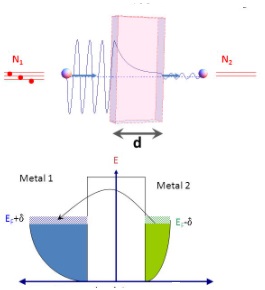 universo embora possam ter explicações, são inefáveis, ou seja, porque mesmo que descrito tem limitações por sua complexidade e não obviedade.
universo embora possam ter explicações, são inefáveis, ou seja, porque mesmo que descrito tem limitações por sua complexidade e não obviedade.
Um destes fenômenos é o tunelamento quântico da mecânica quântica (figura ao lado) no qual as partículas transpõe estados de energia que “logicamente” seriam proibidos, elas escapam de regiões cercadas por barreiras potenciais mesmo tendo energia cinética menor que a barreira.
Einstein, Podolski e Rosen escreveram um artigo (EPR) na década de 20 chamando este efeito de “fantasmagórico” porém na década de 70 ele ficou provado e rompe também com o pensamento clássico que existe A e não-A, não podendo haver terceira hipótese, ela existe e está provada, ao menos na física.
O inefável na vida cotidiana são fenômenos humanos que transpõe a barreira do imaginário e se realizam fisicamente, são mistérios e eles existem não apenas para demonstrar truques que sejam convincentes para divinizar este ou aquele grupo, ou para fazer uma “mágica”, isto é o campo dos charlatães, mas para uma consciência fenomenológica clara de algo além do humano.
Uma das funções da metáfora é poder descrever este fenômeno sem recorrer a uma lógica muito complexa para o senso comum, e permitir que muitas pessoas possam entender estes mistérios.
A figura da parábola entre neste aspecto, com uma pequena diferença da metáfora por usar exemplos do cotidiano e do senso comum, ela é pedagógica ao explicar como o mistério da vida (e também da morte) pode ser visto de modo a entender o destino da humanidade e o que é a vida.
Longe de explicar sua origem no sentido físico, o Gênesis por exemplo, recorre a Adão e Eva, o fato que o homem veio de algum aspecto complexo da natureza é explicado como sendo feito do barro, a metáfora é que o homem veio de compostos orgânicos da natureza, e claro, depois Deus soprou-lhe as narinas e deu “vida” no sentido espiritual, não é difícil entender que esta vida existe.
É hora de mudarmos de via
Não é proposta minha, mas o nome do último livro de 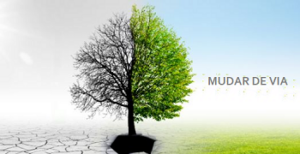 Edgar Morin (Ed. Bertrand do Brasil, 2020), o quase centenário filósofo francês mostra as lições do coronavírus que resistimos em aprender, também é muito parecido ao nome do livro de Peter Sloterdijk: Tens de mudar de vida (editora Relógio d´Água, 2018), este bem antes do coronavírus.
Edgar Morin (Ed. Bertrand do Brasil, 2020), o quase centenário filósofo francês mostra as lições do coronavírus que resistimos em aprender, também é muito parecido ao nome do livro de Peter Sloterdijk: Tens de mudar de vida (editora Relógio d´Água, 2018), este bem antes do coronavírus.
Antes de passar a algumas lições de Morin, quero dizer que TODOS precisamos mudar de vida, o planeta se esgotou, as palavras se esgotaram, a política polarizadora nos esgota, e infelizmente as palavras adocicadas como “fraternidade”, “solidariedade”, “compaixão” e tantas outras parecem só uma vontade de alguns que os outros mudem, sem, contudo, que cada um mude primeiro a si.
O preâmbulo é uma retrospectiva histórica desde a gripe espanhola até maio de 68 e a crise ecológica atual, as lições do coronavírus no capítulo 1 comento-as no final.
Começo pelo fim para afirmar que Morin que também compartilha de valores de fraternidade, de uma cidadania planetária, da superação de desigualdades etc., tem em seu livro ama proposta bem clara, depois de demonstrar que a crise é anterior ao coronavírus que só a agravou, na página 4 sentencia “… são duas as exigências inseparáveis para a renovação política: sair do neoliberalismo, reformar o Estado” (pag. 46), que vai dar os meios no capítulo 3.
Este é na verdade seu segundo ponto do cap. 2 Desafios pós-corona, o desafio da crise política, dos nove desafios que aponta nas crises atuais: o desafio existencial, apontado também na Encíclica Fratelli Tutti do Papa Francisco, os desafios das crises: da globalização, da democracia, do digital, da proteção ecológica, da crise econômica, das incertezas e o perigo de um grande retrocesso (pags. 44 a 53).
As 15 lições do coronavírus: sobre a nossa existência, o isolamento mostra-nos como vivem aqueles que não “tiveram acesso ao supérfluo e ao frívolo e merecem atingir o estágio em que se tem o supérfluo” (pag. 23), sobre a condição humana lembra o relatório Meadows, que apontava para os limites do crescimento, a lição sobre a incerteza de nossa vida, a lição de nossa relação com a morte, a lição sobre a nossa civilização (a vida voltada para fora, sem vida interior, a vida dos shoppings e happy hours), o despertar da solidariedade, a desigualdade e o isolamento social, a diversidade de situações e de gestão da epidemia, a natureza de uma crise, as 9 lições iniciais.
A lição sobre a ciência e a medicina, será que entendemos “que a ciência não é um repertório de verdades absolutas (diferentemente da religião” (pag. 33), a crise da inteligência, que ele divide sabiamente em “complexidades invisíveis” o modo de conhecimento “das realidades humanas (taxa de crescimento, PIB, pesquisas de opinião, etc.” (pag. 35), o ponto 2. é a ecologia da ação, alerta que a ação pode “percorrer o sentido contrário ao esperado e voltar como um bumerangue para a cabeça de quem a decidiu” (pag. 35), quantas ações e discursos caíram nesta vala.
A decima segunda lição é a ineficiência do estado, que além da política neoliberal cede “a pressões e interesses que paralisam todas as reformas” (pag. 38), enquanto a polarização se aprofunda.
A decima terceira lição é a deslocalização e dependência nacional, e lamenta “que o problema nacional seja tão mal formulado e sempre reduzido à oposição entre soberania e globalização” (pag. 39), note-se pelos discursos que polarizam e não saem deste círculo vicioso.
A décima quarta lição é a crise da Europa, lembro do livro de Sloterdijk “Se a Europa despertasse”, e Morin abre a ferida: “sobre o choque da epidemia, a União Europeia partiu-se em fragmentos nacionais” (pag. 40).
A décima quinta lição é o planeta em crise, cita o prof. Thomas Michiels, biólogo e especialistas na transmissão de vírus: “Não há duvida de que a globalização tem efeito sobre as epidemias e favorece a propagação do vírus. Quando se observa a evolução as epidemias do passado, há exemplos notórios em que se nota que as epidemias seguem ferrovias e deslocamentos humanos. Não resta dúvida, a circulação dos indivíduos agrava a epidemia” (pag. 41).
MORIN, E. É hora de mudarmos de via: lições do coronavírus, trad. Ivone Castilho Benedetti, colaboração Sabah Abouessalam. Rio de Janeiro: Bertrand do Brasil, 2020.

